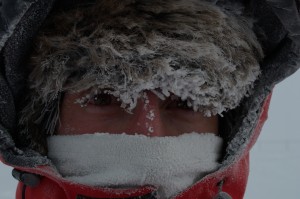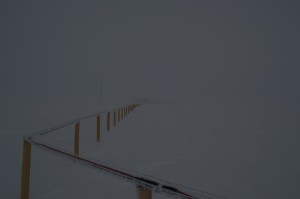
Credits: IPEV/PNRA-A. Litterio
Antonio Litterio describes the never-ending Antarctic battle with the cold. This post should be read while listening to music from pianist Roberto Cacciapaglia:
https://youtu.be/0mld5k_UyH8
Our main protagonist at the beginning of September was the bad weather. The wind, with its icy breath, brings mild temperatures of -46°C down to a -80°C including wind-chill factor. It transforms all that is around me. The vast plateau is immersed in a surreal blinding fog. Tiny ice particles spread the sunlight and the sphere of the Sun is only just visible. On the ground, the wind draws snow crystals with twisting curves of a few centimeters, they seem to be running away from everything while the snow under them hardens like a blanket that does not want to feel the cold. If you venture outside your steps are erased in just a few minutes. As you walk further from the base it gradually gets swallowed by the fog. At first details like the windows disappear until only a faint dark stain on a background of white remains.
It is an unequal struggle. Cold is at home here and plays with us, so the time taken before exiting the building in preparation for these conditions is spent very carefully. I avoid leaving uncovered parts of the body, especially the face and hands, which are the first to suffer.
Once ready you double check in the mirror and walk to the door. The size of the base protects you at first, but once down the stairs you start to feel the wind whistling and penetrate under your hat and clothes. You sense it not only from the noise of the wind but also from the frost on the tip of your ears. You think that you will defeat the cold by protecting yourself with your hands but it is impossible as you realize that your breath freezes the neck guard around the mouth and the cotton becomes hard like cold marble as the folds freeze and rasp along my lips. Eyelashes start to glue shut and it becomes difficult to open my eyes, even my beard gets stuck to the neck guard.
You may wonder: “Why then go out in these conditions? The base is an excellent shelter, an oasis in the middle of this desert of ice, where shelter and calmness awaits.” But a lively curiosity to feel these forces of nature on my skin is stronger than any certainty of comfort. It is a way to escape the monotony, but it is also a way to deal with my thoughts. During the winter I reflected on the climate, and I felt like the snow running away from something, feeling at the mercy of the elements that blind me, unable to see the road ahead. Going outside makes me feel the sensations on my skin and I realise how strong and intense the experience living in Concordia is.
Then slowly there is a glimpse of blue sky that is a prelude to the end of the bad weather. Slowly the wind subsides, and whistles less and less, the pale sun is surrounded by a halo of light, the snow stops because it no longer feels the need to escape , the noises disappear and the plateau slowly returns to its normal calmness while I wait for the wind to give a new dynamism to everything that surrounds me.
Antonio Litterio






Discussion: 3 comments
This one is a great post and the music amplifies the sensation. Thanks. I will be joining you in 1 month at Dome C, hope to have similar stories to tell! Adriano.
I have been enjoying every single one of your posts… thanks for sharing this amazing Concordia experience x
These posts are amazing.
Yes music helps images to slide between our ears but the words and experience told in these posts are amazing. In every post you can learn something unique that people that are not reading will never know.
I am writing you from North Eastern Italy, Friuli. I really enjoyreading in one breath as we say in italian, all the first posts from the most recent down. I enjoy what you say about your experience of explorers, about Luca in relations with you Earthonauts, and even if I am not a doctor or a geologist or pilot I translate for the HiRISE project.
I have a great feeling and I know that I would love to be part of such an experience, soon a day. You made us part already of the experiences with these little essays published here.
Will keep reading while you will turn back to a different life and wish you the best for the next adventures.
Buon viaggio!